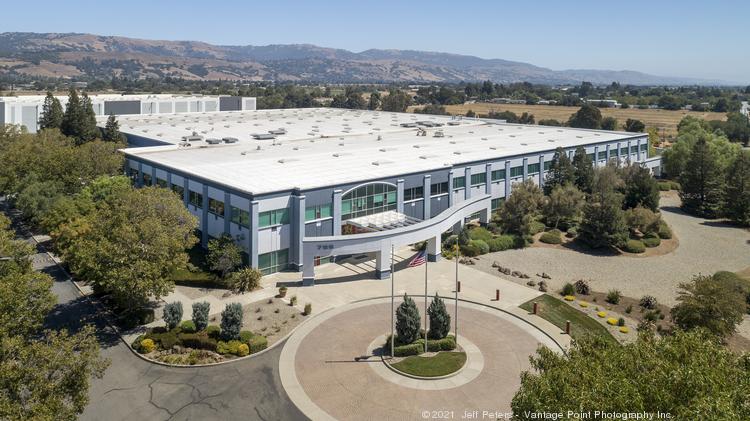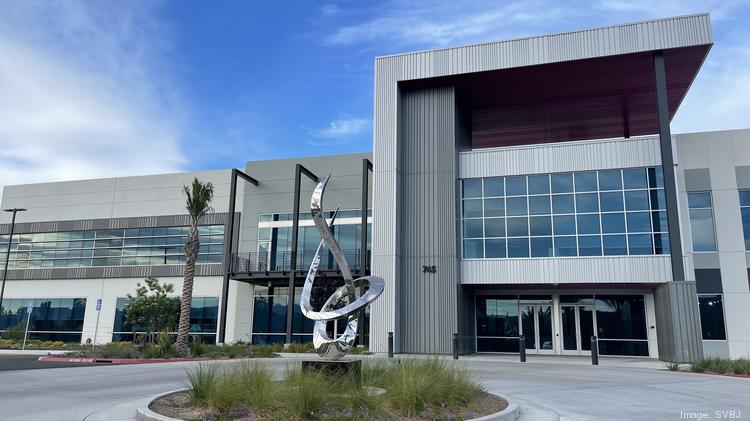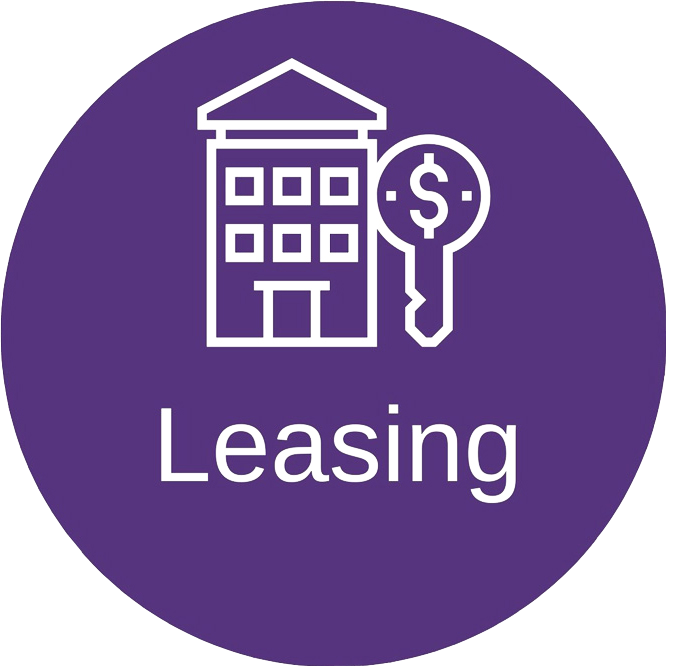
Morgan Hill Gets Industrial
Morgan Hill Gets Industrial
Editor’s note: Join the Business Journal for a special virtual event Aug. 11 to hear more about Morgan Hill’s approach to development. Register for the free event here.
A few minutes north of Morgan Hill’s downtown stand five new buildings in a 410,000-square-foot campus called the Butterfield 5 Tech Park.
It’s everything the city of Morgan Hill wants: new industrial space for a region that’s hungry for it, buildings that are suitable for advanced manufacturing and life-sciences uses with key amenities like numerous electric-vehicle charging stations. Plus, Butterfield 5 is something Morgan Hill’s leaders definitely do not want it to be — a warehouse distribution center for the likes of Amazon.com Inc.
Trammell Crow, the Dallas-based commercial real estate developer, built Butterfield 5 before signing a tenant for the project. In June, as it finished construction, Trammell sold the development for $111 million — more than $291 a square foot — to Invesco Ltd., an Atlanta-based investment management company.
The addition of the industrial center wasn’t just big for Morgan Hill, a city of 48,000 in the southern portion of Santa Clara County. It was the only new industrial development that came online in the second quarter in all of Silicon Valley at a time when demand for such space in the area outpaces available supply by millions of square feet.
“Morgan Hill is going to have attention for a good stretch,” said Brian Matteoni, executive vice president of CBRE, which is handling leasing for Butterfield 5. “They have an existing base of occupiers, some blue-ribbon companies, that have already landed in the market over the years. So it’s a proven sector of Silicon Valley.”
The city has about 6.8 million existing square feet of industrial, R&D and warehouse space, according to the latest quarterly report from brokerage firm Colliers. That’s about 2% of the entire industrial stock of Silicon Valley — in a city that’s just under thirteen square miles in size.
With strong demand for industrial space in the region, real estate investors are being drawn to Morgan Hill, and the city government is augment its healthy retail sector with additional industrial employers.
“There’s only so much retail that 48,000 people can support,” said Matthew Mahood, the city’s economic development director. He continued: “The more employers and employees that come into a city … that’s going to ultimately support additional commercial retail.
Manufacturing gets advanced
Located within the 380-acre Morgan Hill Ranch Business Park – the fifth largest business park in Silicon Valley – Butterfield 5 is just one of several recent industrial developments in the city. Among the others:
- A 501,314-square-foot industrial development Trammel Crow is readying for construction on the eastern side of U.S. Highway 101, south of the Cochrane Road exit.
- Silicon Valley Glass’ 31,172-square-foot headquarters and manufacturing facility, which it completed last year.
- Shoe Palace’s newly built industrial and office building, which is nearly double the space of its previous headquarters next door. The shoe retailer sold that building — a 258,122-square-foot facility — in early June.
A joint venture of Ridge Capital Investors and Westbrook Partners paid about $45 million, or $174 a foot, for the Shoe Palace building, located at 755 Jarvis Dr. The purchase was the first in Morgan Hill for Ridge or Westbrook. The firms made the move to get closer to south Santa Clara County’s manufacturing hub, said CBRE’s Matteoni, who brokered the deal and is the property’s leasing agent.
There’s a lot of “truly organic growth” in advanced manufacturing happening in the area, said David Karol, Ridge’s managing director. Companies that are already operating in Morgan Hill are continuing to expand there. That’s helping spur demand for spaces like the former Shoe Palace headquarters, he said.
This momentum isn’t by accident, city officials say. But it’s starting to become self-sustaining. Investments by well known companies offers a signal to other businesses that the Morgan Hill market is maturing, said Edith Ramirez, who had Mahood’s job before becoming assistant city manger.
“Our economic blueprint and our vision to support growth puts us in a position to attract investors like Trammell Crow,” she said.
Ridge and Westbrook decided to buy an older property rather than developing a new one, because they could see a return more quickly, Karol said. Ridge Capital, Westbrook and the CBRE team are putting $2 million into a renovation and expect to put it up for lease within a short window, he said.
But even as it stands, the property has a lot to like, Karol said. Originally constructed for Abbott Labs’ manufacturing operations, it has plenty of electrical capacity for cooling and to power operations and has copious amounts of parking for employees.
“Where can anyone get more than 200,000 square feet under one roof, with that sort of power, parking and cooling?” he said.
What the city doesn’t want
While Morgan Hill embraces its industrial sector, it’s saying no to warehouse distribution facilities.
“Morgan Hill has been more of a rural community for much of its history,” said Mahood. “The challenge that we have is protecting a very high quality of life that the residents have come to expect, while we also try to grow our employment base, and our revenue base.”
Mahood, who stepped into his job last summer after nine years as head of the Silicon Valley Organization, said that balancing act is what led to a “conversation about how we don’t want to be a distribution center city.”
In mid-March, the City Council adopted what it called an Industrial Preservation and Optimization Policy that would essentially eliminate the construction of any future large warehouse, distribution, or parcel sorting facilities in Morgan Hill. In November, city voters will decide if it stays.
The policy was part of a larger economic framework set up in 2017 to bolster advanced manufacturing — a natural goal given that 20% of Morgan Hill’s workforce already was in that sector, Ramirez said.
As the city matures, its industrial space is becoming more constrained and “severely” limited, said Nick Gaich, CEO of the Morgan Hill Chamber of Commerce.
“How we preserve that for our future economies is very important,” he said.
The city’s industrial policy imposes a number of restrictions — including new limits on dock door heights, door-to-square-foot-ratios and ceiling heights — as a way to guarantee that only new manufacturing and research-and-development projects get built.
“That really signals to the business development community that we’re going to prohibit future large distribution use,” Mahood said. “We are going to encourage advanced manufacturing uses.”
Part of that effort involves actively recruiting manufacturing companies to Morgan Hill, said Gaich, the founder of healthcare consulting firm Gaich and Associates, which is based in the city. Instead of Morgan Hill being seen as a “commuter town,” the policy aims to turn the city into a destination for employers and a potential home for their employees, he said.
“It’s a way to just memorialize the community’s intent with directly where we want to go,” said Gaich, who also co-owns Craft Roots, a vegan bar and grill in the city’s downtown.
“Preserving the industrial land that we have in front of us for advanced manufacturing, research, development, etc. is an important element of us continuing to grow and mature,” he said.
Supply and demand
Morgan Hill’s rise arise as an industrial hub comes as demand for such space throughout Silicon Valley keeps rising. Across the region, CBRE recently counted 44 potential tenants or companies shopping for space averaging at least 132,000 square feet. In total, demand for industrial space amounts to 5.8 million square feet, according to a CBRE report analyzing regional real estate in the second quarter. Yet there were only five properties with more than 100,000 square feet available for lease, the report stated.
Ridge Capital’s Karol expects demand to remain high. With dwindling land available for new ground-up development and rising construction costs, investors are trying to satisfy prospective tenants with existing industrial. “The supply is going to be a challenge in the near term,” Karol said.
Even existing industrial space is harder to find these days. In part that’s because of pressure to demolish and convert older industrial spaces to other “better and higher uses,” said Colin Yasukochi, CBRE’s executive director of the Tech Insights Center.
Industrial was previously considered a “lower value use” that many municipalities have not prioritized, because it’s low-density, Yasukochi said. That perception is starting to change. “You could probably argue that these days, it’s the best performing property out there by far,” he said.
Rents are only expected to go higher because of the demand and supply imbalance, Yasukochi said.
At the end of the second quarter, Morgan Hill had both an 11.1% vacancy and availability rate, the second highest in the region. The only area to have more industrial space available was downtown San Jose, which has less than half of Morgan Hill’s overall industrial square footage.
While it’s one of the only cities left with industrial space, it’s also one of the cheapest places to lease such properties. The average rent there is $1.25 per square foot, compared to $1.43 a foot in North San Jose or $1.63 a foot in Fremont, according to Jones Lang LaSalle Inc.
But these rents aren’t likely to stay low for long, said Karol. “We do see that the supply is not keeping up with demand – currently, historically, or going forward,” Karol said. “So we think [supply] will continue to cause upward pressure on rents as well.”
Even the economic uncertainty that’s hit many sectors of the economy isn’t enough to temper enthusiasm for Morgan Hill’s industrial market, Karol said. One reason for that is that manufacturing work has to be done on site. And having workers physically inside industrial facilities gives investors a more tangible idea of how these spaces are used, Karol said.
One of the final hurdles for Morgan Hill is a perception that the city is further away from the epicenter of Silicon Valley than it actually is, Ramirez said.
“For us, growing that connective tissue with the rest of Silicon Valley is interesting,” she said.






